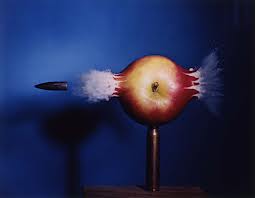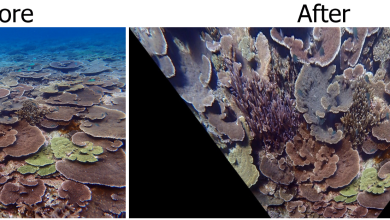Light in slow motion
For one of our last meetings of the semester, Student Astronomical Society members shared any astronomy/space/science news they had come across. I found this TED video on femto-photography to be a really interesting look at a really exciting field, as it has many unique future applications.
The picture above is from about fifty years ago when the first camera came out that could take pictures at a million frames per second—fast enough to watch a bullet in slow motion. This picture was inspiration for some MIT students to make a camera that can take a trillion frames per second—fast enough to watch light in slow motion!
 The femto camera recorded a “bullet” of light (called a packet of photons) as it traveled through a bottle in slow motion, pictured above. The ball of light, upon hitting the cap, scattered into ripples of light as separate photons bounced off in various directions. To put into perspective how fast this camera is capturing images – if a femto camera were used to record a bullet traveling through the same bottle, the video would last an entire year before the bullet reached the cap of the bottle, while the light only took a few seconds to travel that far! Quite an amazing feat.
The femto camera recorded a “bullet” of light (called a packet of photons) as it traveled through a bottle in slow motion, pictured above. The ball of light, upon hitting the cap, scattered into ripples of light as separate photons bounced off in various directions. To put into perspective how fast this camera is capturing images – if a femto camera were used to record a bullet traveling through the same bottle, the video would last an entire year before the bullet reached the cap of the bottle, while the light only took a few seconds to travel that far! Quite an amazing feat.
Some proposed uses of the femto camera are the possible ability to see around corners or to use it for health imaging. The team at MIT set up an experiment to see if they could reconstruct an object hidden around a corner using the femto camera. The idea is that the camera sends light at a wall and the light bounces off of that around the corner and hits a hidden object. The light then bounces back off of the object and to the wall, to return to the femto camera. Since a bunch of bounced light returned to the camera once the experiment was actually run, dozens of pictures had to be taken, but once all of them were compared and analyzed, the team was able to reconstruct a fairly decent idea of what was behind the wall, as shown below. It is a rough start, but it is still more than we used to have. This kind of technology could help police officers out in the field, could alert cars to oncoming collisions around bends or could tell rescuers if any survivors were in a building, and where. The same technique could be used for health imaging, except the camera would have to be a lot smaller. Imagine a world where we could see into the body without using an x-ray machine! Colonoscopies would be a lot more comfortable and cardioscopy would be safer. Pretty cool, right? The amazing world of science, ladies and gentlemen.
Pictures courtesy of: http://www.techi.com/2012/08/femto-photography-one-trillion-frames-per-second/ , http://marianaetienne.blogspot.com/2012/09/one-trillion-frames-per-second.html#!/2012/09/one-trillion-frames-per-second.html , http://corlenegreenwood.blogspot.com/2012/08/femto-cameras-that-see-around-corners.html , and http://www.tumblr.com/tagged/femtophotography







